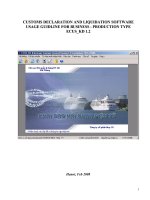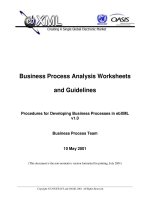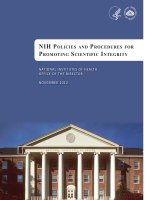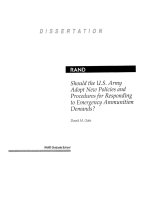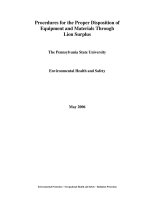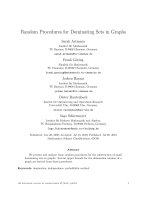243. [Implementing customs procedures for exporting plywood for business purpose at U&I Logistics - Northern JSC]
Bạn đang xem bản rút gọn của tài liệu. Xem và tải ngay bản đầy đủ của tài liệu tại đây (3.64 MB, 60 trang )
MINISTRY OF FINANCE
ACADEMY OF FINANCE
--------
Student: Phung Quang Huy
Class: CQ54/05.04
GRADUATION THESIS
TOPIC:
[Implementing customs procedures for export plywood
for business purpose at U&I Logistics – Northern
Joint Stock Company]
Major
: Customs and Foreign Trade
Student’s ID
: 165D3402011906
Instructor
: Dr. Thai Bui Hai An
HA NOI - 2020
ACKNOWLEDGMENTS
I hereby declare that this thesis is my own research project, the data
and results stated in the graduation thesis are honest, stemming from the
practical situation of the intern.
Student
(Sign and Name)
LIST OF ABBREVIATIONS
AMA
:
Registration of amended tax information
ASEAN
:
Association of Southeast Asian Nations
C/O
:
Certificate of Origin
Co., Ltd
:
Limited Liability Company
CUS
:
Customer Service Department
EIR
:
Equipment Interchange Receipt
HAN
:
Ha Noi
HPH
:
Hai Phong
JSC
:
Joint Stock Company
LC
:
Letter of Credit
OPS
:
Operations Department
VNACCS
:
Vietnam Automated Cargo Clearance System
LIST OF DIAGRAMS
Diagram
2.1
2.2
Page
Organization structure of U&I Logistics – Northern
15
JSC
The percentage of channel into which plywood export 36
declarations are directed in 2019
LIST OF FIGURES
Figure
Page
2.1
Quotation
18
2.2
Communication channel - Zalo
19
2.3
VNACCS user’s information
19
2.4
Selecting qualified container
20
2.5
Export declaration form
21
2.6
Attaching export documents
22
2.7
Infrastructure fee declaration
23
2.8
Fumigation certificate
24
2.9
Phytosanitary certificate
25
2.10
Registration of amended tax information (AMA)
26
2.11
Equipment Interchange Receipt - EIR
27
2.12
Bill of Lading
28
2.13
Certificate of Origin
29
2.14
Letter of Credit – LC
30
TABLE OF CONTENTS
Cover page...................................................................................................i
Acknowledgments........................................................................................ii
Table of contents..........................................................................................iii
List of abbreviations.....................................................................................iv
List of diagrams............................................................................................v
List of figures...............................................................................................vi
PREAMBLE................................................................................................1
Chapter 1: THEORETICAL FRAMEWORK ON CUSTOMS PROCEDURES
FOR EXPORT PLYWOOD
1.1. Theoretical framework on Customs procedures....................................3
1.1.1. Concepts of Customs procedures .................................................3
1.1.2. Basic properties of customs procedures .......................................3
1.1.3. Contents of implementing customs procedures for export goods 5
1.1.4. Principles of implementing customs procedures..........................6
1.2. General issues of export goods.............................................................8
1.2.1. Basic concepts...............................................................................8
1.2.1.1. Goods.................................................................................8
1.2.1.2. Means of transport..............................................................9
1.2.2. Location and time limit for customs procedures...........................10
1.3. Implementing customs procedures for export plywood........................11
1.3.1. Prepare documents for export goods.............................................11
1.3.2. Declaring and submitting customs declarations............................11
1.3.3. Additional declaration of customs declaration forms...................12
1.3.4. Prepare customs documents..........................................................12
1.3.5. Customs procedure at Customs Sub-Department.........................12
1.3.6. Customs clearance.........................................................................13
1.3.7. Customs supervision performance................................................13
1.4. Legal basis for implementing customs procedures for export plywood
......................................................................................................................14
1.4.1. International legal basis................................................................14
1.4.2. National legal basis.......................................................................14
Chapter 2: CURRENT SITUATION OF IMPLEMENTING CUSTOMS
PROCEDURES FOR EXPORT PLYWOOD AT U&I LOGISTICS – NORTHERN
JOINT STOCK COMPANY
2.1. Overview of U&I Logistics – Northern JSC.........................................16
2.1.1. General introduction about U&I Logistics – Northern JSC..........16
2.1.2. Organization structure...................................................................16
2.2. Current situation of implementing customs procedures for export
plywood at U&I Logistics – Northern JSC..................................................17
2.2.1. Export plywood procedure at U&I Logistics – Northern JSC......17
2.2.2. Process of implementing customs procedures for export plywood at
U&I Logistics – Northern JSC................................................................31
2.2.2.1. Prepare documents for submitting customs declaration.....31
2.2.2.2. Submitting customs declarations........................................33
2.2.2.3. Examining customs documents and physical condition of
good.................................................................................................34
2.2.2.4. Additional declaration of customs declaration forms.........35
2.2.2.5. Customs clearance..............................................................35
2.2.2.6. Bringing goods into customs supervision areas.................36
2.2.3. Results of implementing customs procedures for export plywood at
U&I Logistics – Northern JSC................................................................36
2.3. Evaluating the process of implementing customs procedures for export
plywood products at U&I Logistics – Northern JSC...................................38
2.3.1. Advantages in carrying out customs procedures for export plywood
products at U&I Logistics – Northern JSC.............................................38
2.3.2. Difficulties and limitations in the process of carrying out customs
procedures for export plywood products at U&I Logistics – Northern JSC
.................................................................................................................39
Chapter 3: SOME SOLUTIONS TO IMPROVE EFFICIENCY OF
IMPLEMENTING CUSTOMS PROCEDURES FOR EXPORT PLYWOOD
PRODUCTS AT U&I LOGISTICS – NORTHERN JSC IN THE COMING TIME
3.1. Development orientation of U&I Logistics – Northern JSC.................40
3.1.1. General development orientation of U&I Logistics – Northern JSC
.................................................................................................................40
3.1.2. Development orientation of export plywood products of U&I
Logistics – Northern JSC in the coming time.........................................41
3.2. Some solutions to improve efficiency of implementing customs
procedures for export plywood at U&I Logistics – Northern JSC in the
coming time..................................................................................................41
3.2.1. Improving facilities and technology.............................................41
3.2.2. Arranging, training and improving the quality of human resources
.................................................................................................................42
3.2.3. Updating information and regulations on customs laws regularly
and constantly.........................................................................................43
3.2.4. Improving the process of implementing customs procedures.......43
3.2.5. Establishing relationships with customers and partners in the same
field.........................................................................................................44
3.3. Some recommendations to authority agencies for successfully
implementation of the solutions...................................................................45
3.3.1. Recommendations to Customs authority......................................45
3.3.2. Recommendations to other authorities..........................................46
CONCLUSION............................................................................................47
REFERENCES.............................................................................................48
1
PREFACE
1.
The necessity of the subject:
According to the Vietnam Logistics Report 2018 and 2019 published
by the Ministry of Industry & Trade Publisher: Vietnam is the country with
the highest export growth rate compared to other ASEAN countries such as
Indonesia, Thailand, Singapore and Malaysia. On the other hand, plywood
and lumber are groups of goods which have the highest growth rate among all
Vietnam's export groups in 2018, showing that plywood is an important
export goods, which should be focused to invest by Vietnamese business.
Therefore, it can be seen that the need to carry out customs procedures
for export plywood products will increase in the coming time, requiring a
greater number of qualified human resources for this activity.
For those reasons, the author has chosen the topic “Implementing
customs procedures for export plywood for business purpose at U&I
Logistics – Northern Joint Stock Company" for the graduation thesis.
Plywood is common export goods. Most plywood products are
exported under the form of business and investment. However, plywood can
also be exported under export processing form. Within the scope of the study,
the author only studies customs procedures for exporting this product with
the object of business purpose. From now on, export plywood products for
business purpose will be called as export plywood for short.
2.
Research objectives:
The research objectives are as follows:
2
-
Researching general theoretical issues about customs procedures
for export goods in general and export plywood in particular.
-
Studying the current situation of implementing customs
procedures for export plywood at an enterprise.
-
Propose some solutions to
improve the efficiency of
implementing customs procedures for export plywood at the enterprise in the
coming time.
3.
Research subject and scope:
-
Subject of the research: Customs procedures for export plywood
at enterprise.
-
Scope of the research: Customs procedures for export plywood
at U&I Logistics – Northern JSC from 2018 to 2019.
4.
Research methodology:
The topic is studied based on the method of problem analysis
theoretical and practical topics in a scientific and logical way, combining
interpretation with inductive, between words and illustrations, actual testing
methods and drawing conclusions.
5.
The structure of the topic:
Besides the introduction and conclusion, the content of the thesis
consists of three chapters:
Chapter 1: Theoretical framework on customs procedures for export
plywood
3
Chapter 2: Current situation of implementing customs procedures for
export plywood at U&I Logistics – Northern Joint Stock Company
Chapter 3: Some solutions to improve efficiency of implementing
customs procedures for export plywood products at U&I Logistics – Northern
Joint Stock Company in the coming time
4
CHAPTER
1:
THEORETICAL
FRAMEWORK
ON
CUSTOMS
PROCEDURES FOR EXPORT PLYWOOD
1.1. Theoretical framework on Customs procedures
1.1.1. Concepts of Customs procedures
Up to now, in all countries in the world, regardless of the political
regime, every country has a foreign economic policy, a tariff policy, and also
regulations on import and export procedures, and setting up the agency in
charge of implementing these procedures and regulations and collecting
export and import taxes at the same time.
This procedure is collectively referred to as customs declaration. As for
the agency in charge of carrying out customs procedures, each country has
different names but the contents of customs procedures are the same.
According to Vietnam Customs Law: "Customs procedures mean the
formalities
which
shall
be
performed
by
the
customs
declarant
and customs officers in accordance with this Law in respect of goods or
means of transport."
Therefore, customs procedures are understood to mean all operations
and tasks that customs declarants, customs officers and related parties (such
as warehousing companies, ports, and specialized management agencies)
must comply with the provisions of law on export, import goods, exit, entry
and transit transport vehicles.
1.1.2. Basic properties of customs procedures
Customs procedures have following basic properties:
Compulsorily administrative property: Customs procedures are
administrative procedures because the implementation of customs procedures
5
is the act of executive power in the field of customs and by the state
administrative management agency, which specifically is the customs office.
In principle, all export, import, exit, entry and transit goods and means of
transport must be performed customs procedures; if customs procedures are
not carried out or customs procedures are improperly and incompletely as
prescribed by law, customs clearance is not permitted, and thus, export and
import acts cannot be implemented. All contents of the work of customs
procedures are specified in the Customs Law and documents guiding the
implementation of the Customs Law. Customs declarants and customs
officers have the responsibility to coordinate with each other and coordinate
with other State agencies in carrying out those tasks.
Sequent and continuous property: The procedure refers to its
sequencing, which refers to which, which steps are performed first, which
steps are followed. The result of the previous step is the premise and the basis
for the next step. The following is done based on the results of the previous
step and is the successor of the previous step. At the same time, the next step
must check the results of the previous step to minimize errors in the customs
clearance procedure. Customs procedures must be carried out continuously
without interruption to ensure quick clearance and create favorable conditions
for international trade activities.
Consistent property: Consistency is reflected in the fact that customs
procedures must be uniform from the scheme of documents, must be uniform
from the regulations that the documents must be submitted, must be
presented, and must be uniform in the handling and results. Handling
between Sub-Departments, Departments and the whole industry; unifying the
operations throughout the customs clearance procedure; agreed at all customs
clearance locations nationwide, not allowing customs procedures at this
location to be different from customs procedures done at other locations.
6
Publicity, pellucidity and internationalization: In order to ensure the
consistency of customs procedures, customs procedures must be open and
pellucid, because this is a mandatory administrative procedure. This feature is
shown in the fact that customs procedures are specified in legal documents
and posted, propagated and disseminated on the mass media; be posted at
customs clearance locations.
Customs procedures are the tasks that customs declarants and customs
officers must perform for exported, imported goods, transport means on exit,
entry and in transit. Therefore, the implementation of customs procedures
greatly affects international trade. Accordingly, in order to develop the
economy, to integrate into the world, it is necessary to harmonize the customs
procedures and the customs procedures must be in accordance with
international treaties and international regulations on customs.
1.1.3. Contents of implementing customs procedures for export goods
Customs procedures are administrative procedures, carried out
primarily and directly by customs declarants and customs officers.
While carrying out customs procedures, the customs declarant shall be
responsible for:
- Filling in and submitting customs declaration forms; submitting or
produce documents of customs files;
- Taking goods and means of transport to prescribed places for physical
inspection;
- Paying duties and fulfilling other financial obligations in accordance
with law provisions on taxes, charges and fees and other relevant laws;
7
While carrying out customs procedures, Customs and customs officers
shall be responsible to:
- Receiving and registering customs files;
- Examining customs files and conducting physical inspection of goods
and means of transport;
- Collecting duties and other amounts in accordance with law
provisions on taxes, charges and fees and other relevant laws;
- Decision on customs clearance and release of goods and certifying
the completion of customs procedures of means of transport.
In the group of customs procedures for export goods, they are divided
into many small groups, for example, customs procedures for business
purpose, customs procedures for non-business purpose...
Based on the method of carrying out customs procedures, customs
procedures are classified into:
- Traditional customs procedures (manual customs procedures) are
customs procedures carried out by manual method, paper customs declaration
and directly handling by customs officers as prescribed, following the law.
- Modern customs procedures (electronic customs procedures): are
customs procedures performed by electronic data transferred through the
electronic data processing system of the customs authorities as prescribed,
following the law.
1.1.4. Principles of implementing customs procedures
8
Principles of implementing customs procedures are the guiding
thoughts that customs declarants and customs officers must follow when
carrying out customs procedures for goods and transport means.
When carrying out customs procedures, both customs declarants and
customs officers must abide by the following principles:
- All goods and means of transport must go through customs
procedures. This means irrespective of whose goods and means of transport,
what their origin, what type of export or import, when participating in
international trade relations or on the move, and moving from one legal area
to another, those subjects must be fulfilled customs duties. Objects carried out
customs procedures include export, import goods, transport means on exit,
entry and in transit.
- Applying risk management principles in customs procedures. Risk
management is the systematic application of measures, business processes
and practices to help customs authorities arrange and manage appropriate
resources to focus on effective management of different fields, the object is
determined to be a risk. Risk management is concerned as an advanced and
modern management method applied by customs authorities in many
countries around the world and has proved its great efficiency. As a result,
there is a balance between facilitation and strict control in the context of a
surge in trade and global chain.
- Ensuring the effectiveness and efficiency of state management of
customs and facilitating export and import activities. The implementation of
customs procedures must aim towards two basic goals. One is to ensure the
strict and effective management of the state in the field of customs. The other
is to facilitate export and import activities, or in other words, to international
trade.
9
- Customs clearance, transport means are allowed to exit, enter or
transit after customs procedures have been completed. Customs clearance is
the completion of customs procedures for goods to be imported, exported or
put under other professional customs management regime. Therefore, in
principle, goods and transport means, after customs procedures have been
completed, may be cleared, except for other cases prescribed by law, such as
suspension of customs clearance at the request of owners of intellectual
property rights, suspecting that exports or imports infringe intellectual
property rights or apply coercive measures of competent state agencies to
fulfill tax obligations.
- Customs procedures must be conducted publicly, quickly,
conveniently and strictly according to law provisions. This principle stems
from the basic properties of customs procedures, stems from the
characteristics of international trade activities as well as the requirements of
national management of customs.
- Customs procedures must meet the requirements of export and
import activities. This principle is reflected in the arrangement of manpower
and working time must meet the requirements of export and import activities.
The arrangement of manpower and working time of the customs authorities
as well as enterprises must conform to the provisions of the customs law and
in accordance with the reality of international trade activities.
1.2. General issues of export goods
1.2.1. Basic concepts
1.2.1.1.
Goods
According to the Vietnam Customs Law, goods include movables with
names and codes according to Vietnam's List of Exports and Imports that are
exported, imported, transited or stored in customs operating areas.
10
Goods that are subjects to customs procedures include:
- Export, import and transit goods;
- Luggage, foreign exchange and Vietnamese currency of people on
exit, entry or in transit;
- Items on transport means on exit, entry or in transit;
- Metal, precious stones, antiques, cultural products, postal matters and
other properties exported, imported, transited or kept within the geographical
areas of customs operation.
Exported goods are goods allowed to leave the customs territory, the
place of origin of goods after the customs procedures related to such goods
have been completed.
1.2.1.2.
Means of transport
Traditionally, vehicles are special structured vehicles for transporting
goods, passengers, luggage, or other necessary materials moving from one
space to the other space within a certain period of time required for
transportation.
Means of exit, entry and transit transport have the following
characteristics:
- Vehicles on exit, entry or in transit have a specific structure in service
of the transport of goods, passengers, luggage or other material;
- Possessed nationality and legal owner;
- Comply with the legal system of international transport and the
bilateral agreement between countries on exit, entry and transit;
11
- Move in and out of the border of a country and must be carried out
necessary customs procedures in accordance with the laws of that country.
Regardless of whether the vehicle is foreign or national, that vehicle has
nationality.
1.2.2. Location and time limit for customs procedures
Location for carrying out customs procedures is understood as the
place where customs declarants submit customs declarations to the officers,
and where customs offices receive and register customs declarations, carry
out and handle operations to clear goods and means of transport.
The time limit for carrying out customs procedures is the time period
when customs declarants submit customs declarations, submit relevant
documents of customs declaration and customs offices receive, register and
examine customs documents, or actual goods.
According to the provisions of the Vietnam Customs Law, the time
limit for submission of customs declarations for exported goods is prescribed
as follows: "For exported goods, to submit the declaration after bringing
goods at the location, customs declarants notify and at least 04 hours before
the means of transport leave; For exported goods sent by express service, the
latest 02 hours before the means of transport leave".
Customs declarations are valid for carrying out customs procedures
within 15 days from the date of registration.
Time limit for completing customs procedures of customs authorities:
Customs offices shall receive, register and check customs documents
as soon as customs declarants submit and produce customs documents
according to law provisions.
12
After the customs declarant fulfills the requirements for carrying out
customs procedures, the time limit for customs officers to complete document
examination and physical inspection of goods is prescribed as follows:
- Complete the document examination within 02 working hours from
the time the customs office receives the full customs document;
- Completing the actual inspection of goods within 08 working hours
from the time the customs declarant presents all goods to the customs office.
In case goods are subject to specialized inspection of quality, health, culture,
quarantine of animals, plants and food safety in accordance with relevant
laws, the time limit for completion of physical inspection actual goods are
calculated from the time of receiving the results of specialized inspection as
prescribed.
In case the shipment has a large quantity, many types or complicated
inspection, the head of the customs office where the customs procedures are
carried out shall decide to extend the actual inspection time of the goods, but
the extended time is maximum 02 days.
1.3. Implementing customs procedures for export plywood
1.3.1. Prepare documents for export goods
The set of documents for export plywood includes: Commercial
contract; Commercial invoice; Packing list; Booking note; Certificate of
origin; Phytosanitary certificate; Certificate of Fumigation.
1.3.2. Declaring and submitting customs declarations
Customs declaration is the process by which customs declarants
provide customs offices with information and data on objects of customs
procedures in the forms prescribed by law.
13
Customs declaration is the first legal act performed by the customs
declarant to perform customs clearance of goods, and is also the initial legal
basis for customs officers to carry out customs inspection.
According to the provisions of the Vietnam Customs Law: "Customs
declaration shall be made electronically, except for cases where customs
declarants are required to fill in paper customs declarations according to the
Government's regulations".
When submitting electronic customs declaration, the customs declarant
shall: Submitting information about the customs declaration on the electronic
customs declaration system; Sending the customs declaration to the customs
authority through the customs electronic data processing system; Receiving
feedbacks and follow customs authorities' instructions.
1.3.3. Additional declaration of customs declaration forms
Customs declarants may additionally fill in customs declaration after
the system has directed in into channels but before the customs offices
conduct direct inspection of customs documents.
Additional declaration contents include: Information objects of the
electronic customs declaration, except for information items objects are not
allowed to be additionally declared.
In case of correcting the cleared declaration, and those information
objects are not supported to be additionally declared by the System, the
declarant needs to prepare a set of documents to correct the declaration,
including: Customs declaration; Official correspondence for additional
declaration; Documents related to additional declaration.
1.3.4. Prepare customs documents
14
The obligatory customs documents for export plywood goods includes:
Export customs declaration; Commercial invoice; List of forest products.
1.3.5. Customs procedure at Customs Sub-Department
Basing itself on the notification of the results of the flow of customs
declarations of the System, the decision of the Director of the Customs Subdepartment where the declaration is registered or the Customs Subdepartment where the actual inspection of goods and customs declaration is
submitted, information on risk indications on the System, customs officers
notify customs declarants through the System about the submission,
presentation of one to the entire documents of the customs documents and
perform detailed examination of customs declaration, physical inspection of
goods. In case of physical inspection of goods, officers must confirm the
inspection results on the record of inspection results, update them into the
System and decision on customs clearance. Releasing goods or bringing them
to storage.
In the context of customs inspection, if detecting signs of violation of
customs law or tax law, customs officers shall report and propose to the
Director of the Customs Sub-Department to decide to change to appropriate
inspection level.
In case of customs inspection, if it is required to solicit expertise for
customs inspection, customs offices shall have to pay expenses.
1.3.6. Customs clearance
Exported plywood products are not subject to tax before customs
clearance, so after completing the customs procedures at the Customs SubDepartment where the declaration is submitted, the customs officer will issue
a clearance decision through Electronic customs system.
15
1.3.7. Customs supervision performance
Vietnam Customs Law stipulates the time for customs supervision of
exported goods as follows: “Exported goods exempted from actual inspection
of goods are subject to customs supervision from the time of customs
clearance until out of the customs area. In cases where physical inspection is
required, the exported goods shall be subject to customs supervision from the
time of actual physical inspection of goods till the exit of the geographical
areas of customs operation."
Typical methods of customs supervision are mainly: Customs sealing;
Direct supervision of customs officers; Supervision by technical equipment.
1.4.
Legal basis for implementing customs procedures for export
plywood
1.4.1. International legal basis
The international legal basis is the documents developed by countries
agreed to and commonly known as international treaties, including
international treaties on customs and international treaties related to customs,
including:
- The Kyoto Convention 1973 and the revised Kyoto Convention in
1999 on simplification and harmonization of customs procedures;
- HS Convention on goods classification in 1988;
- GATT preferential tariff and trade agreements
- Cites Convention;
- Vienna Convention of 1969 on the Law of International Treaties...
1.4.2. National legal basis
16
National legal basis or National Law means legal documents
promulgated by competent state agencies of the State of the Socialist
Republic of Vietnam according to the order and procedures prescribed by law
specified.
National legal bases include legal documents on customs and legal
documents related to customs activities, including:
- Customs Law 2014;
- Commercial Law 2005;
- Decree No. 08/2015/ND-CP dated January 21, 2015 of the
Government detailing and enforcing Customs Law regarding customs
procedures, customs inspection, supervision and control;
- Circular No. 38/2015/TT-BTC dated 25 March 2015 of the Ministry
of Finance providing for customs procedures; customs inspection and
supervision; import and export duties and tax administration on imports and
exports;
- Circular No. 39/2018/TT-BTC dated April 20, 2018 of the Ministry of
Finance on amending and supplementing a number of articles in Circular No.
38/2015 / TT-BTC;
- Circular No. 15/2018/TT-BNNPTNT dated October 29, 2018 of the
Ministry of Agriculture and Rural Development on promulgating HS codes
for the list of goods under the management of the Ministry of Agriculture and
Rural Development.
In addition to the above sources of international law, customs
procedures for exported goods are also governed by international customs
and practices related to customs.
17
Principle of application of a legal basis is that national laws must be
applied first. Then international laws, to which Vietnam has signed or
recognized, shall be applied in case the situations are not circulated by
national laws. In cases where national laws or international laws do not
contain provisions, international customs and practices related to customs
may apply.


